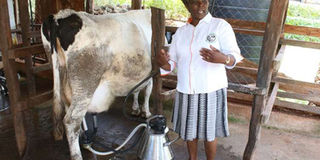New, faster way to detect mastitis

Hellen Weru milks a cow at her farm in Ihiga-ini village in Nyeri County. Each time your cow leaves the milking parlour, ensure the teats are dipped in a teat dip and dried. Dirty cowsheds and use of a single towel to clean teats of several cows are among practices that lead to the spread of Mastitis. PHOTO | JOSEPH KANYI | NATION MEDIA GROUP
What you need to know:
- Researchers in the US have developed a simple test to detect mastitis.
- Dirty cowshed and use of a single towel to clean teats of several cows are practices that spread the disease.
- One of the tests farmers in Kenya use to detect mastitis is by milking from each teat small drops on the palm to check the flow. If the milk is thick and flows slowly, a farmer knows that particular teat may be infected by mastitis.
Researchers in the US have developed a simple test to detect mastitis, a disease that costs farmers huge losses.
The test detects subclinical mastitis by screening a sample of a cow’s milk for specific enzymes.
The test by Deryl Troyer, a professor of anatomy and physiology at Kansas University and Stefan Bossmann, a professor of chemistry, uses nanotechnology to positively identify mastitis in dairy cattle earlier and costs less than current technologies on the market.
Mastitis is a disease that inflames and eventually scars the udder tissue of dairy cows, reducing milk production and altering composition. It is the most common disease in dairy farms across the world.
“The classical mastitis tests estimate the numbers, not the activity, of neutrophil cells, which are the dominant cells that travel to the inflamed udder during mastitis,” Prof Troyer said this week.
“Many times early and emerging cases of mastitis are not caught by the tests because they count the numbers rather than the activity. These are often the most important cases to catch,” he added.
Early detection will help farmers treat cows better with emerging cases of mastitis as well as reduce transmission to other cows in the dairy operation.
The nanoplatform technology quickly detects cancer cells and tumours before physical symptoms ever appear.
The researchers said that the test easily translated to mastitis detection because several of the enzymes that cause inflammation in human cancers also cause inflammation in the udder of the dairy cows.
DETECT SUBCLINICAL MASTITIS IN LESS THAN FIVE MINUTES
“We looked at about 30 enzymes and identified three that are highly indicative of mastitis,” Prof Bossmann said. “These three enzymes and this nanoplatform make it possible to detect preclinical mastitis cases that have high enzymatic activity but a low somatic cell count. These cases have previously been undiscoverable because there is no test in the market for this combination.”
To test for mastitis, a sample of pasteurised milk is put into a buffer solution containing the enzyme-detecting nanoplatform. The nanoplatform consists of iron nanoparticles coated with amino acids and a fluorescent dye.
The amino acids and dye interact with enzymes in the milk. The sample is incubated for up to 30 minutes and then examined for three enzymes that cause mastitis.
Recent tests in the reseachers’ laboratories have detected subclinical mastitis in less than five minutes.
The researchers said their mastitis test could be used today by large-scale dairies and eventually by robotic dairy facilities, and even farmers in developing countries like Kenya.
One of the tests farmers in the country use to detect mastitis is by milking from each teat small drops on the palm to check the flow.
If the milk is thick and, thus, flows slowly, a farmer knows that particular teat may be infected by mastitis. But this is rudimentary, and by this time, the disease is at advanced stage.
Dirty cowsheds and use of a single towel to clean teats of several cows are among practices that lead to the spread of the disease in the country.
Science Daily
***
more about the disease
- Mastitis is a menace to dairy farmers, affecting negatively milk production, cows’ health and longevity.
- The impact is more severe in high-producing exotic cattle and their crosses.
- The disease refers to inflammation of the mammary glands, particularly milk producing cells.
- Three classes of mastitis have been identified. These are:
i) Acute mastitis, characterised by observable changes in milk and udder, affecting one quarter, several or all.
ii) Sub-acute mastitis, characterised by less severe signs.
iii) Chronic mastitis, characterised with recurrent episodes. - Mastitis is caused by myriad of micro-organism (germs) originating from the animals circulatory system and from the environment.
- Of importance are micro-organisms originating from the animals’ environment. One should, therefore, maintain a high standard of hygiene in the dairy unit.
- These can be controlled by observing proper milking order, hygiene and providing proper bedding.
An option of vaccination exists but it is recommendable to consult registered animal health personnel for treatment and further guidance on control and vaccination.




